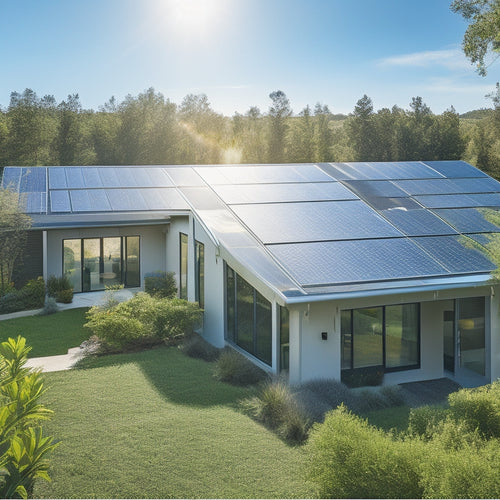
Portable Power Inverters for RV and Camping
Share
When shopping for a portable power inverter for your RV or camping setup, you'll want to take into account key features like portability, safety certifications, and efficiency ratings. Choose an inverter that can handle your daily energy needs, with a continuous power output exceeding your total wattage requirements. Verify the inverter can also handle brief surges in power demand. Look for certifications like UL and ETL, which guarantee compliance with industry standards. By selecting the right inverter, you'll be able to enjoy reliable power on the go. Now, investigate the various types of inverters and their unique benefits to find the perfect fit for your off-grid expedition.
Overview
- When choosing a portable power inverter for RV and camping, consider the inverter's continuous power output, surge capacity, and efficiency rating.
- Look for certifications like UL and ETL to ensure the inverter meets industry safety standards and is designed for reliable performance.
- Evaluate the inverter's portability, compact design, and lightweight construction for easy transport and storage in RVs and camping setups.
- Consider the inverter's ability to handle specific voltage and frequency requirements of appliances, as well as its waveform type (modified sine or pure sine).
- Prioritize safety features such as built-in fuses, surge protectors, and short-circuit protection to ensure safe and reliable power supply during outdoor activities.
Understanding Solar Power Inverters
Investigate the world of solar power inverters, an important component in utilizing renewable energy for your RV or camping excursions.
You'll appreciate the solar energy benefits, including reduced carbon footprint and lower energy costs.
When sizing an inverter, it's vital to evaluate daily energy usage and consider factors like roof orientation and electrical infrastructure.
However, it's essential to prioritize inverter safety precautions to guarantee a reliable and secure power supply.
When selecting an inverter, look for certifications like UL and ETL, which ensure compliance with industry standards.
Additionally, consider the maximum power point tracking (MPPT) feature, which optimizes energy collection from your solar panels.
Choosing the Right Inverter Size
Since you've determined your daily energy needs, now it's vital to select an inverter that can handle your power requirements.
You'll want to choose an inverter with a continuous power output that meets or exceeds your total wattage needs. Consider the surge capacity as well, as it guarantees the inverter can handle brief spikes in power demand.
When selecting an inverter, it's important to prioritize off-grid energy systems that can efficiently convert renewable energy sources like solar power. Efficient solar power conversion and reliable energy storage options are significant for ideal system performance.
Inverter compatibility is also important; verify the inverter can handle the specific voltage and frequency of your appliances.
Don't forget to check the inverter's efficiency rating, as it affects the overall performance. By selecting the right inverter size, you'll enjoy reliable power on the go, without worrying about equipment damage or safety risks.
Types of Solar Inverters Available
You'll find several types of solar inverters available, each designed to cater to specific needs and applications.
For instance, grid tie inverters are ideal for connecting to the grid and selling excess energy back to the utility company, offering benefits such as seamless energy selling and significant savings on electricity bills.
High-efficiency inverter options with high conversion efficiency ratings, typically above 95%, can also be considered for peak energy harvesting.
Off grid inverters, on the other hand, are perfect for remote areas where grid connection isn't possible.
When it comes to waveform, you can choose between modified sine and pure sine inverters, with the latter being more suitable for sensitive electronics.
Inverter chargers combine the functions of an inverter and a charger, making them a great option for RV and camping applications.
Additionally, microinverters, string inverters, and power optimizers offer more specialized solutions for specific solar panel configurations.
Key Features to Consider Buying
Your portable power inverter is only as dependable as the features it possesses, so it's vital to prioritize the right ones when making a purchase.
When shopping for a portable power inverter, consider the portability options that matter to you. Do you need a compact design that fits easily in your RV or camping gear? Or perhaps a lightweight model that won't weigh you down?
Safety features are also significant, as they protect you and your devices from damage. Look for inverters with built-in fuses, surge protectors, and short-circuit protection.
Additionally, consider the inverter's certifications, such as UL or ETL, which guarantee compliance with safety standards.
Inverter Efficiency and Performance
When it comes to inverter efficiency and performance, the numbers matter. You want to verify your portable power inverter can handle your energy needs without wasting power.
Look for inverters with high efficiency ratings, typically above 90%. This means the inverter can convert most of the DC power from your battery to usable AC power. Inverter technology plays a significant role in energy conversion, so a high-performance inverter is essential.
Check the continuous power output and surge capacity to confirm it can handle your appliances' power requirements. A high-quality inverter will provide a stable and reliable power supply, giving you the freedom to enjoy your RV or camping trip without worrying about energy constraints.
Installation and Maintenance Tips
Three key considerations should guide your portable power inverter's installation: safety, ventilation, and accessibility. You should always follow the manufacturer's instructions and take necessary precautions to avoid electrical shock or fire hazards. Guarantee good airflow around the inverter to prevent overheating, and install it in an easily accessible location for maintenance and troubleshooting.
| Installation Checklist | Inverter Safety Tips |
|---|---|
| Check the inverter's maximum power rating | Avoid overloading the inverter |
| Guarantee proper ventilation around the inverter | Keep the inverter away from flammable materials |
| Install the inverter in an accessible location | Regularly inspect the inverter's cables and connections |
Top Brands for RV and Camping
Since you've carefully evaluated the installation and maintenance of your portable power inverter, it's time to investigate the top brands for RV and camping.
When making your selection, you'll want to weigh factors like power output, efficiency, and durability.
Based on inverter comparisons, some of the best portable power inverter brands for RV and camping include Renogy, Goal Zero, and AIMS Power.
These brands offer reliable and efficient products that can handle a range of power needs.
Renogy's inverters are known for their high surge capacity, while Goal Zero's products are popular for their ease of use.
AIMS Power offers a wide range of inverters with varying power outputs.
Frequently Asked Questions
Can I Use a Portable Inverter With a Lithium-Ion Battery?
You can use a portable inverter with a lithium-ion battery, but make certain it's compatible with the inverter type; pure sine wave or modified sine wave inverters work well, while some lithium-ion batteries require specific charging protocols.
Are Portable Power Inverters Suitable for Marine Applications?
As you steer through the open waters, you wonder if portable power inverters can keep up with your marine journeys. The answer lies in their marine power capabilities: if you choose an inverter with sufficient capacity, it'll efficiently convert DC power to AC, fueling your freedom on the seas.
Do I Need a Special License to Install an Inverter in My Rv?
You don't need a special license to install an inverter in your RV, but you must comply with inverter installation requirements and guarantee RV electrical safety by following manufacturer guidelines and local regulations to avoid electrical hazards.
Can I Charge My Inverter Using a Wind Turbine?
You wonder if utilizing the wind's power can charge your inverter, but first, you must guarantee the turbine's efficiency matches your inverter's compatibility; then, and only then, can you release the freedom of renewable energy on the open road.
Are Portable Power Inverters Compatible With European Electrical Systems?
When traveling to Europe, you'll need to verify your portable power inverter is compatible with their electrical systems, which operate at 230V, 50Hz; look for inverters with European voltage compatibility and high inverter efficiency ratings to confirm seamless power conversion.
Ready to Buy
When venturing into the world of portable power inverters for RV and camping, remember that "well begun is half done." By understanding your power needs, choosing the right inverter size, and considering key features, you'll be well on your way to utilizing the sun's energy. With the right inverter, you'll enjoy reliable power on the go. So, don't get left in the dark - invest in a high-quality portable power inverter that meets your RV and camping needs.
Related Posts
-

Sustainable and Eco-Friendly Generators for a Reduced Carbon Footprint
Sustainable and eco-friendly generators are perfect for cutting your carbon footprint and increasing energy efficienc...
-

Top Portable Refrigerators for Camping Adventures
When you're camping, having a reliable portable refrigerator can make all the difference for keeping your food fresh ...
-

Installing Metal Solar Roofs for Maximum Energy Efficiency
Installing metal solar roofs can drastically enhance your home's energy efficiency and durability. These roofs withst...


